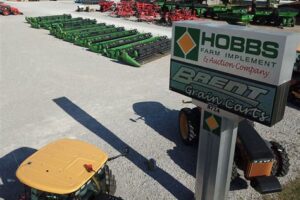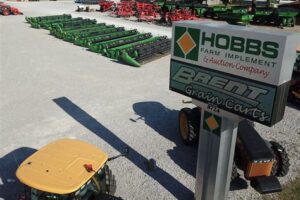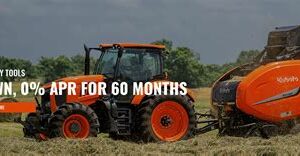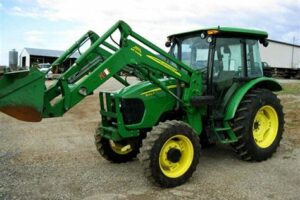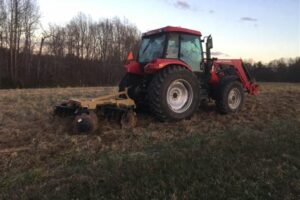Table of Contents
Discover who has the right-of-way when it comes to farm equipment in Ohio. Understand the laws and regulations surrounding this topic to ensure safe and respectful interactions on the road. Stay informed and learn how to navigate shared spaces with agricultural vehicles in the state of Ohio.
When it comes to navigating roads in rural Ohio, one might find themselves sharing the pavement with a peculiar set of vehicles – farm equipment. These massive machines, designed to plow fields and harvest crops, often require significant space and time to maneuver. This begs the question: do these agricultural giants have the right-of-way on Ohio roads? Exploring this topic is essential for both drivers and farmers alike, as understanding the rules and regulations surrounding farm equipment can help ensure safe and efficient travel for all parties involved.
Introduction
Farm equipment plays a crucial role in the agriculture industry, aiding farmers in various tasks such as planting, harvesting, and transportation. However, these large and slow-moving vehicles can sometimes create confusion on the roads, particularly when it comes to right-of-way rules. In the state of Ohio, understanding the right-of-way regulations involving farm equipment is essential for both farmers and other road users to ensure safe navigation and minimize potential accidents. This article will delve into the specifics of whether farm equipment has the right-of-way in Ohio.
Defining the Right-of-Way
Before delving into Ohio’s regulations, it is vital to understand the concept of right-of-way. Right-of-way refers to the privilege of one vehicle or pedestrian to proceed ahead of others in a particular situation, ensuring smooth traffic flow and prioritizing safety. It is a legal principle that helps to prevent accidents and streamline the movement of vehicles and people on the roadways.
Ohio’s Regulations on Farm Equipment
In Ohio, farm equipment is subject to specific regulations regarding right-of-way. According to the Ohio Revised Code (ORC), farm equipment does have the right-of-way in certain situations. ORC 4511.55 states that farm machinery and implements of husbandry must be given the right-of-way when moving between fields or operating on the roadway. This law recognizes the need to prioritize the safe passage of farm equipment due to their size, limited speed, and unique handling characteristics.
The Duties of Other Road Users
While farm equipment is granted the right-of-way in Ohio, it does not mean that other road users are absolved of their responsibilities. The ORC also outlines the duties of drivers encountering farm equipment on the roadway. According to ORC 4511.55, drivers approaching or overtaking farm machinery must exercise due care and caution, reduce speed if necessary, and maintain a safe distance when passing. This ensures the safety of both the farm equipment operator and the other motorists on the road.
Exceptions to Farm Equipment Right-of-Way
While farm equipment is generally granted the right-of-way in Ohio, there are exceptions to this rule. ORC 4511.55 specifies that farm equipment should yield the right-of-way when an authorized emergency vehicle, such as a police car, ambulance, or fire truck, is approaching with its lights and sirens activated. In such cases, farm equipment operators must safely move off the road or pull over to allow the emergency vehicle to pass promptly.
Roadway Considerations for Farm Equipment
Farm equipment operators are also expected to follow certain rules when operating on the roadway. ORC 4511.55 states that farm machinery should operate as close as practical to the right-hand edge of the roadway, allowing faster vehicles to safely pass when the width and condition of the roadway permit. This consideration ensures that traffic flow is not unduly disrupted and minimizes any potential hazards caused by slow-moving vehicles.
Additional Safety Measures
To enhance safety and minimize accidents involving farm equipment, both farmers and other road users should take additional precautions. Farmers operating farm equipment on roadways should ensure all required lighting and marking devices are properly functioning. These include headlights, taillights, reflectors, and flashing amber warning lights. Additionally, displaying reflective slow-moving vehicle (SMV) emblems on the rear of the equipment is highly recommended to increase visibility and alert other motorists.
Driver Awareness and Patience
On the other hand, drivers encountering farm equipment should exercise patience and be aware of their surroundings. Slow down when approaching or following farm machinery and maintain a safe distance. Be cautious when passing, ensuring there is enough space and clear visibility before overtaking. It is crucial to remember that farm equipment operators may not always have optimal visibility due to their size and design. By being patient and considerate, drivers can play their part in ensuring safe travel for everyone on the road.
Conclusion
In Ohio, farm equipment does have the right-of-way in specific situations, as outlined by the Ohio Revised Code. However, this does not exempt other road users from their duties and responsibilities when encountering farm machinery. By understanding and adhering to these regulations, both farmers and drivers can contribute to safer roads and minimize accidents. Patience, caution, and awareness are key when sharing the road with farm equipment, ultimately ensuring the well-being of all those involved in Ohio’s agricultural industry and beyond.
Understanding Right-Of-Way Laws in Ohio
In Ohio, right-of-way laws dictate who has priority when it comes to traffic movement. While there are specific rules for different situations, there is no universal right-of-way for farm equipment. Instead, farm equipment operators must follow general traffic rules and exercise caution to ensure safe road use.
Farm Equipment’s Obligations on Public Roads
When operating farm equipment on public roads in Ohio, farmers must abide by various laws and regulations. This includes having appropriate licensing, ensuring their equipment is in good working condition, and following the same traffic laws as other vehicles. Although farm equipment does not have automatic right-of-way privileges, the size and slower speed of this equipment often require courteous consideration from other motorists.
Yielding to Traffic on Public Roads
Farm equipment operators are expected to yield to other traffic when legally required. This means that if a farm vehicle is approaching an intersection where a stop sign or traffic signal is present, it must come to a complete stop, give right-of-way to vehicles with the legal right to proceed, and then proceed with caution while following traffic laws. It is essential for farm equipment operators to be aware of and respect the right-of-way of other vehicles.
Sharing the Road with Farm Equipment
Motorists in Ohio are also expected to exercise caution when approaching or passing farm equipment on the road. When approaching farm equipment, drivers should reduce their speed, maintain a safe following distance, and be patient. Passing farm equipment should only be done when it is safe and legal to do so, using caution and observing all traffic rules.
Wide Load Identification and Escort Requirements
If farm equipment such as large combines or machinery exceeds certain size limits, it may be considered a wide load. In such cases, the operator is required to display appropriate signage and may need to arrange for an escort vehicle to ensure the safe passage of the wide-load equipment. Failure to comply with these requirements can lead to penalties and compromise road safety.
Farm Equipment on Local Roads
When using local roads, farm equipment operators need to be especially mindful of their surroundings. Motorists should be prepared to encounter farm equipment, especially in rural areas, and adjust their driving behavior accordingly. Both farmers and motorists must exercise caution and communicate to promote safe and efficient road use.
Promoting Awareness and Safety
To enhance road safety, the Ohio Department of Agriculture and other relevant authorities provide educational resources and promote awareness campaigns focused on farm equipment operation. These initiatives aim to educate both farmers and motorists about their respective responsibilities, fostering a shared understanding and respect to reduce the risk of accidents and improve overall traffic flow.
Reporting Unsafe Farm Equipment Operation
If motorists encounter farm equipment operators who are not following traffic laws or endangering others on the road, it is important to report such instances to the appropriate authorities. By doing so, individuals can contribute to maintaining road safety and holding those who violate regulations accountable, ensuring the well-being of all road users.
Point of View: Does Farm Equipment Have The Right-Of-Way In Ohio
- Farm equipment, being essential for agricultural operations, should have the right-of-way on Ohio roads.
- Ohio law recognizes the importance of farm equipment and grants them certain rights on the road.
- Granting farm equipment the right-of-way promotes safety on the roads.
- Respecting the right-of-way for farm equipment supports the economic growth of Ohio’s agricultural sector.
- Motorists should exercise patience and understanding when encountering farm equipment on the road.
Ohio’s agricultural industry plays a vital role in providing food and resources to its residents and beyond. Therefore, it is crucial to prioritize the movement of farm equipment to ensure the smooth functioning of these operations.
The Ohio Revised Code Section 4511.55 acknowledges the significance of farm machinery and implements. It states that farm equipment, when traveling on public roads within one mile of a farm, has the right-of-way over other vehicles except emergency vehicles.
Considering the size and slower speed at which farm equipment operates, it is essential to protect both the operators and other road users from potential accidents. By granting the right-of-way to farm equipment, Ohio encourages safe practices and reduces the risk of collisions or hazards.
By allowing farm equipment to move efficiently and effectively, Ohio demonstrates its commitment to supporting the state’s agriculture industry. This helps farmers transport goods, complete necessary tasks, and maintain their livelihoods without unnecessary delays or interruptions.
It is crucial for motorists to recognize the importance of farm equipment and be considerate while sharing the road. Slowing down, maintaining a safe distance, and waiting for appropriate passing opportunities can significantly contribute to the overall safety and well-being of all road users.
In conclusion, providing the right-of-way to farm equipment in Ohio is not only legally mandated but also crucial for ensuring the smooth operation of the agricultural industry, promoting safety on the roads, and supporting economic growth. Motorists should demonstrate patience and understanding when encountering farm equipment, ultimately fostering a harmonious coexistence between agricultural activities and the general public.
Thank you for taking the time to read our blog post on the topic of Does Farm Equipment Have The Right-Of-Way In Ohio. We hope that we were able to provide you with valuable information and insights into this important issue. As always, it is crucial to understand the laws and regulations governing right-of-way in order to ensure the safety and well-being of all road users, including farmers and agricultural equipment operators.
In Ohio, farm equipment does indeed have certain rights-of-way under specific circumstances. It is vital for both farmers and other motorists to be aware of these rights and to exercise caution and patience when encountering farm equipment on the roads. Ohio Revised Code 4511.55 outlines the rules for operating farm equipment on public highways, and it is important to familiarize yourself with these regulations to avoid any potential conflicts or accidents.
When encountering farm equipment on the road, it is essential to remember that these vehicles are often large, slow-moving, and may require wide turns. As such, it is crucial to exercise patience and give them ample space to maneuver safely. Additionally, it is important to note that farmers are legally obligated to use reflective emblems and lighting devices on their equipment to enhance visibility, especially during low-light conditions. As responsible motorists, we should always be alert and cautious when sharing the road with agricultural vehicles.
Ultimately, understanding and respecting the rights-of-way for farm equipment in Ohio is a shared responsibility. By familiarizing ourselves with the relevant laws and regulations, as well as by exercising patience and caution when encountering agricultural vehicles on the road, we can help ensure the safety of both farmers and other motorists. Let us all strive to promote a harmonious and safe coexistence on the roads, where everyone can travel without unnecessary risks or conflicts.
Thank you once again for visiting our blog and we hope that you found this post informative. If you have any further questions or would like to learn more about this topic, please feel free to reach out to us. Safe travels!
Video Does Farm Equipment Have The Right-Of-Way In Ohio
People Also Ask about Does Farm Equipment Have The Right-Of-Way In Ohio:
-
What are the right-of-way rules for farm equipment in Ohio?
Farm equipment in Ohio is granted the right-of-way under certain circumstances. According to Ohio law, when a farm tractor or other slow-moving vehicle is being operated on a public road, it must be given the right-of-way by other vehicles. This means that drivers of motor vehicles must yield to farm equipment and allow it to proceed safely.
-
Why does farm equipment have the right-of-way in Ohio?
Farm equipment is granted the right-of-way in Ohio due to its slower speed and limited maneuverability compared to regular motor vehicles. As these vehicles are often large and bulky, they require more time and space to safely navigate the roads. Granting them the right-of-way helps ensure the safety of both the operators of the farm equipment and other motorists on the road.
-
What should I do if I encounter farm equipment on the road in Ohio?
If you come across farm equipment on the road in Ohio, it is important to remember to yield the right-of-way to them. Slow down and maintain a safe distance behind the equipment, allowing the operator enough room to see you in their mirrors. Avoid passing the farm equipment unless it is absolutely necessary and safe to do so.
-
Are there any exceptions to the right-of-way rules for farm equipment in Ohio?
While farm equipment generally has the right-of-way in Ohio, there are a few exceptions. If the farm equipment is turning left and a vehicle behind it intends to turn left as well, the motor vehicle may pass the farm equipment on the left. Additionally, if the farm equipment is traveling at a speed of 25 miles per hour or more, it is required to display a slow-moving vehicle emblem and may be subject to different rules.
-
Can farm equipment cause traffic delays in Ohio?
Yes, farm equipment can cause traffic delays in Ohio. Due to their size and slower speeds, farm equipment may impede the flow of traffic on public roads. It is important for motorists to exercise patience and understanding when encountering farm equipment on the road, as they play a vital role in the agricultural industry and have a legitimate need to use public roads for transportation.
Note: Always refer to the most up-to-date Ohio traffic laws and regulations to ensure compliance with current legislation.

